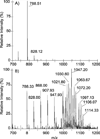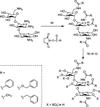Synthesis, separation, and characterization of amphiphilic sulfated oligosaccharides enabled by reversed-phase ion pairing LC and LC-MS methods
- PMID: 22015170
- PMCID: PMC3221801
- DOI: 10.1016/j.carres.2011.09.020
Synthesis, separation, and characterization of amphiphilic sulfated oligosaccharides enabled by reversed-phase ion pairing LC and LC-MS methods
Abstract
Synthesis of amphiphilic oligosaccharides is problematic because traditional methods for separating and purifying oligosaccharides, including sulfated oligosaccharides, are generally not applicable to working with amphiphilic sugars. We report here RPIP-LC and LC-MS methods that enable the synthesis, separation, and characterization of amphiphilic N-arylacyl O-sulfonated aminoglycosides, which are being pursued as small-molecule glycosaminoglycan mimics. The methods described in this work for separating and characterizing these amphiphilic saccharides are further applied to a number of uses: monitoring the progression of sulfonation reactions with analytical RP-HPLC, characterizing sulfate content for individual molecules with ESI-MS, determining the degree of sulfation for products having mixed degrees of sulfation with HPLC and LC-MS, and purifying products with benchtop C18 column chromatography. We believe that the methods described here will be broadly applicable to enabling the synthesis, separation, and characterization of amphiphilic, sulfated, and phosphorylated oligosaccharides and other types of molecules substituted to varying degrees with both anionic and hydrophobic groups.
Copyright © 2011 Elsevier Ltd. All rights reserved.
Figures








Similar articles
-
Analysis of heparan sulfate oligosaccharides with ion pair-reverse phase capillary high performance liquid chromatography-microelectrospray ionization time-of-flight mass spectrometry.J Am Chem Soc. 2002 Jul 24;124(29):8707-18. doi: 10.1021/ja0178867. J Am Chem Soc. 2002. PMID: 12121115
-
Impurity profiling of micronomicin sulfate injection by liquid chromatography-ion trap mass spectrometry.J Pharm Biomed Anal. 2013 Mar 5;75:94-104. doi: 10.1016/j.jpba.2012.11.029. Epub 2012 Nov 27. J Pharm Biomed Anal. 2013. PMID: 23261805
-
Improved separation and characterization of lipopolysaccharide related compounds by reverse phase ion pairing-HPLC/electrospray ionization-quadrupole-mass spectrometry (RPIP-HPLC/ESI-Q-MS).J Chromatogr B Analyt Technol Biomed Life Sci. 2010 Feb 1;878(3-4):442-8. doi: 10.1016/j.jchromb.2009.12.028. Epub 2010 Jan 4. J Chromatogr B Analyt Technol Biomed Life Sci. 2010. PMID: 20061194
-
Sulfated oligosaccharides: new targets for drug development?Curr Med Chem. 2009;16(18):2338-44. doi: 10.2174/092986709788453096. Curr Med Chem. 2009. PMID: 19519394 Review.
-
Forced degradation and impurity profiling: recent trends in analytical perspectives.J Pharm Biomed Anal. 2013 Dec;86:11-35. doi: 10.1016/j.jpba.2013.07.013. Epub 2013 Jul 31. J Pharm Biomed Anal. 2013. PMID: 23969330 Review.
Cited by
-
Selective inhibition of bacterial and human topoisomerases by N-arylacyl O-sulfonated aminoglycoside derivatives.ACS Med Chem Lett. 2013 May 9;4(5):470-474. doi: 10.1021/ml3004507. ACS Med Chem Lett. 2013. PMID: 23814643 Free PMC article.
-
N-Arylacyl O-sulfonated aminoglycosides as novel inhibitors of human neutrophil elastase, cathepsin G and proteinase 3.Glycobiology. 2016 Jul;26(7):701-709. doi: 10.1093/glycob/cww011. Epub 2016 Feb 5. Glycobiology. 2016. PMID: 26850997 Free PMC article.
-
Ultra-high-performance liquid chromatography charge transfer dissociation mass spectrometry (UHPLC-CTD-MS) as a tool for analyzing the structural heterogeneity in carrageenan oligosaccharides.Anal Bioanal Chem. 2022 Jan;414(1):303-318. doi: 10.1007/s00216-021-03396-3. Epub 2021 May 29. Anal Bioanal Chem. 2022. PMID: 34050776
-
Oligosaccharide analysis by mass spectrometry: a review of recent developments.Anal Chem. 2014 Jan 7;86(1):196-212. doi: 10.1021/ac403969n. Epub 2013 Dec 16. Anal Chem. 2014. PMID: 24313268 Free PMC article. Review. No abstract available.
References
-
- Dreyfuss JL, Regatieri CV, Jarrouge TR, Cavalheiro RP, Sampaio LO, Nader HB. An. Acad. Bras. Cienc. 2009;81:409–429. - PubMed
-
- Hacker U, Nybakken K, Perrimon N. Nat. Rev. Mol. Cell Biol. 2005;6:530–541. - PubMed
-
- Zhang L. In: Glycosaminoglycan (GAG) Biosynthesis and GAG-Binding Proteins. Lijuan Z, editor. Vol. Volume 93. San Diego: Academic Press; 2010. pp. 1–17. - PubMed
-
- Capila I, Linhardt RJ. Angew. Chem. Int. Ed. Engl. 2002;41:391–412. - PubMed
-
- Powell AK, Yates EA, Fernig DG, Turnbull JE. Glycobiology. 2004;14:17R–30R. - PubMed
Publication types
MeSH terms
Substances
Grants and funding
LinkOut - more resources
Full Text Sources
Other Literature Sources

